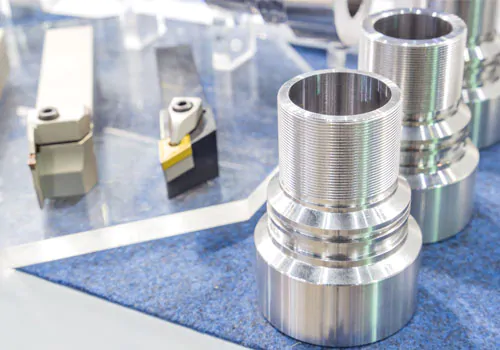Metal Injection Moulding (MIM) and CNC machining are two highly effective manufacturing processes, each with unique strengths and applications. Selecting the right method is crucial for achieving cost efficiency, precision, and high-quality production outcomes.
This comprehensive guide compares MIM and CNC machining to help you decide which manufacturing technique best meets your project’s needs.
At a Glance: Metal Injection Moulding vs CNC Machining
| Feature | MIM | CNC Machining |
|---|---|---|
| Method | Additive Process | Subtractive Process |
| Best For | Complex geometries, high-volume | High precision, smaller volumes |
| Precision | Moderate | Exceptional |
| Production Time | Longer initial setup | Faster turnaround |
| Cost | Higher initial tooling cost | Cost-effective for small runs |
Table of Contents:
- What is Metal Injection Moulding (MIM)?
- What is CNC Machining?
- Key Differences Between MIM and CNC Machining
- When to Choose MIM
- When to Choose CNC Machining
- Summary: MIM vs CNC Machining
- Additional Resources
What is Metal Injection Moulding (MIM)?
Metal Injection Moulding (MIM) is an advanced manufacturing technique combining injection moulding and powdered metallurgy.
It creates high-strength metal parts by injecting finely powdered metal mixed with polymer binders into precision moulds. After injection, the parts undergo debinding and sintering processes at elevated temperatures, resulting in dense, robust metal components.

What is CNC Machining?
Computer Numerical Control (CNC) machining involves automated, computer-guided removal of material from solid metal blocks or billets.
CNC machines precisely cut, drill, and shape metal to exact specifications defined by CAD/CAM software. CNC machining is ideal for producing intricate parts with tight tolerances and high precision.

Key Differences Between MIM and CNC Machining:
Manufacturing Process
- MIM: Additive process; powdered metal feedstock combined with polymer binder is injected into moulds and sintered at high temperatures to form solid parts.
- CNC Machining: Subtractive process; precise removal of excess material from a solid metal billet to achieve the desired final shape.
Input Materials
- MIM: Powdered metal feedstock mixed with polymer binders, processed under high pressure and temperature.
- CNC Machining: Direct input material, typically solid metal stock like steel, aluminium, or titanium.
Design Capabilities
- MIM: Excellent for complex, intricate geometries and detailed features, allowing parts consolidation and significant design flexibility.
- CNC Machining: Good design flexibility but limited by the capabilities of CAD/CAM software, tooling accessibility, and operator skills.
Strength and Performance
- MIM: Produces parts with uniform internal structures and minimal internal stresses due to the additive, sintering process. Ideal for complex designs requiring inherent strength.
- CNC Machining: Strong and reliable, though parts may experience minor internal stresses or micro-deformations from material removal processes.
Tolerance and Precision
- MIM: Tolerances typically range from ±2% to ±0.4%, influenced by shrinkage (15–18%) during the sintering process. Shrinkage can vary due to gravity, drag forces, and mould shape, potentially leading to non-isotropic deformities.
- CNC Machining: High precision, typically ±0.005 inches, capable of achieving tolerances as tight as ±0.001 inches, resulting in less error-prone parts.
Production Time
- MIM: Production cycle varies greatly; generic parts with existing moulds can be completed in hours, but specialised parts requiring new moulds can extend lead times significantly, up to several weeks.
- CNC Machining: Consistently rapid turnaround; delays usually limited only to initial CAD/CAM programming and occasional specialised tooling setups. Once configured, production can commence immediately and efficiently.
Cost Considerations
- MIM: Higher initial investment due to mould costs; metal feedstock is more expensive compared to direct raw input used for CNC machining, potentially increasing overall production costs. Cost-effective primarily for large production volumes with existing moulds.
- CNC Machining: Lower upfront investment, particularly suitable for smaller batches, custom components, or rapid prototyping. Efficient and predictable, reducing costs associated with delays.
Waste Generation
- MIM: Minimal scrap waste due to additive nature of the process, resulting in efficient use of material.
- CNC Machining: Generates significant scrap material due to the subtractive process, requiring robust waste handling, recycling, and disposal strategies.
When to Choose MIM
Consider MIM if your project requires:
- High-volume production with repeatable precision
- Intricate shapes and complex geometries
- Reduced post-production processes
- Economical scaling after initial tooling investment
When to Choose CNC Machining
CNC machining suits your project if you need:
- Exceptional precision and accuracy
- Short production cycles and rapid prototyping
- Small batch production or custom parts
- Quick turnaround without significant initial costs
Summary: Metal Injection Moulding vs CNC Machining
| Feature | MIM | CNC Machining |
|---|---|---|
| Manufacturing Process | Additive | Subtractive |
| Input Material | Powdered metal feedstock | Solid metal billets |
| Complexity & Geometry | Excellent | Good, but limited |
| Strength & Performance | Very high | High |
| Tolerance & Precision | Moderate | Exceptional |
| Production Time | Longer initial setup | Faster turnaround |
| Cost | Higher initial tooling | Lower for small runs |
| Waste Generation | Minimal | Significant scrap |
Additional Resources
- Explore Goudsmit UK’s Metal Injection Moulding Services
- Explore Goudsmit UK’s CNC Machining Services
- Download our Manufacturing Process Brochure
About the Author:
Peter Jacobs
Peter Jacobs is the Senior Director of Marketing at CNC Masters. He is actively involved in manufacturing processes and regularly contributes his insights for various manufacturing blogs.







